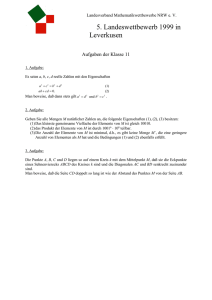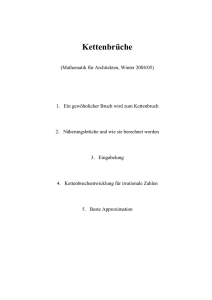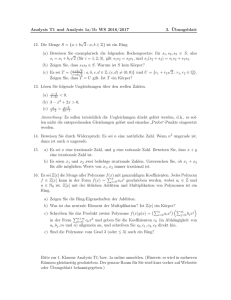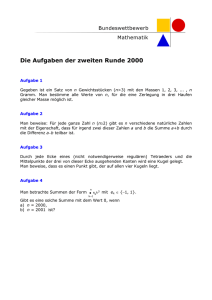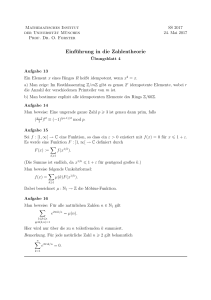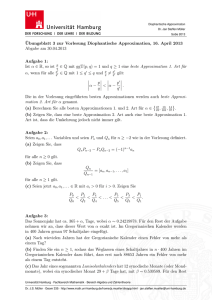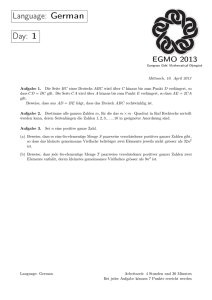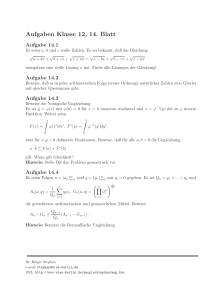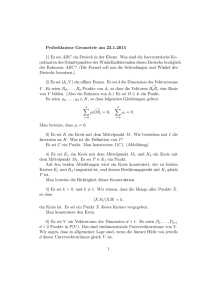Inhaltsverzeichnis
Werbung
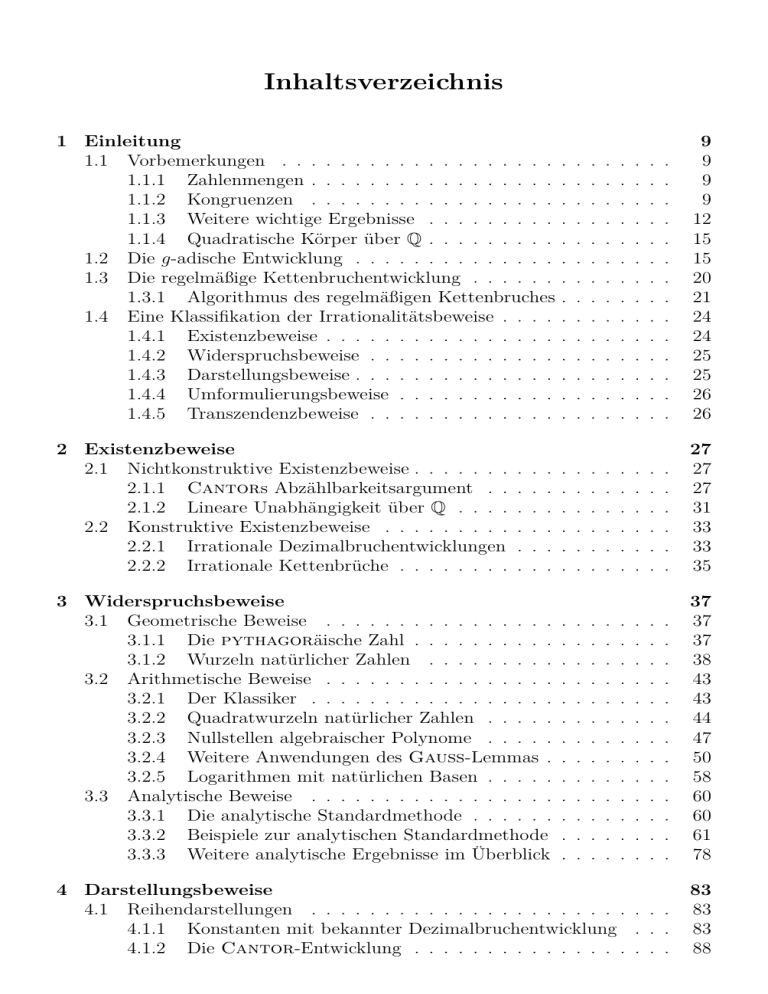
Inhaltsverzeichnis 1 Einleitung 1.1 Vorbemerkungen . . . . . . . . . . . . . . . . . . . 1.1.1 Zahlenmengen . . . . . . . . . . . . . . . . . 1.1.2 Kongruenzen . . . . . . . . . . . . . . . . . 1.1.3 Weitere wichtige Ergebnisse . . . . . . . . . 1.1.4 Quadratische Körper über Q . . . . . . . . . 1.2 Die g-adische Entwicklung . . . . . . . . . . . . . . 1.3 Die regelmäßige Kettenbruchentwicklung . . . . . . 1.3.1 Algorithmus des regelmäßigen Kettenbruches 1.4 Eine Klassifikation der Irrationalitätsbeweise . . . . 1.4.1 Existenzbeweise . . . . . . . . . . . . . . . . 1.4.2 Widerspruchsbeweise . . . . . . . . . . . . . 1.4.3 Darstellungsbeweise . . . . . . . . . . . . . . 1.4.4 Umformulierungsbeweise . . . . . . . . . . . 1.4.5 Transzendenzbeweise . . . . . . . . . . . . . . . . . . . . . . . . . . . . . . . . . . . . . . . . . . . . . . . . . . . . . . . . . . . . . . . . . . . . . . . . . . . . . . . . . . . . . . . . . . . . . . . . . . . . . . . . . . . . . . . . . . . . . . . . . . . . . 9 9 9 9 12 15 15 20 21 24 24 25 25 26 26 2 Existenzbeweise 2.1 Nichtkonstruktive Existenzbeweise . . . . . . . 2.1.1 Cantors Abzählbarkeitsargument . . 2.1.2 Lineare Unabhängigkeit über Q . . . . 2.2 Konstruktive Existenzbeweise . . . . . . . . . 2.2.1 Irrationale Dezimalbruchentwicklungen 2.2.2 Irrationale Kettenbrüche . . . . . . . . . . . . . . . . . . . . . . . . . . . . . . . . . . . . . . . . . . . . . . . . . . . . . . . . 27 27 27 31 33 33 35 . . . . . . . . . . . . . 37 37 37 38 43 43 44 47 50 58 60 60 61 78 4 Darstellungsbeweise 4.1 Reihendarstellungen . . . . . . . . . . . . . . . . . . . . . . . . . 4.1.1 Konstanten mit bekannter Dezimalbruchentwicklung . . . 4.1.2 Die Cantor-Entwicklung . . . . . . . . . . . . . . . . . . 83 83 83 88 . . . . . . . . . . . . . . . . . . 3 Widerspruchsbeweise 3.1 Geometrische Beweise . . . . . . . . . . . . . . . . 3.1.1 Die pythagoräische Zahl . . . . . . . . . . 3.1.2 Wurzeln natürlicher Zahlen . . . . . . . . . 3.2 Arithmetische Beweise . . . . . . . . . . . . . . . . 3.2.1 Der Klassiker . . . . . . . . . . . . . . . . . 3.2.2 Quadratwurzeln natürlicher Zahlen . . . . . 3.2.3 Nullstellen algebraischer Polynome . . . . . 3.2.4 Weitere Anwendungen des Gauß-Lemmas . 3.2.5 Logarithmen mit natürlichen Basen . . . . . 3.3 Analytische Beweise . . . . . . . . . . . . . . . . . 3.3.1 Die analytische Standardmethode . . . . . . 3.3.2 Beispiele zur analytischen Standardmethode 3.3.3 Weitere analytische Ergebnisse im Überblick . . . . . . . . . . . . . . . . . . . . . . . . . . . . . . . . . . . . . . . . . . . . . . . . . . . . . . . . . . . . . . . . . . . . . . . . . . . . . . . . . . . . . . . . . . . 8 Inhaltsverzeichnis 4.2 4.3 Kettenbruchentwicklungen . . . . . . . . . . . . . . . . . . . . . . 94 4.2.1 Die Sätze von Euler und √ Lagrange . . . . . . . . . . . 94 4.2.2 Ein weiterer Beweis für 2 . . . . . . . . . . . . . . . . . . 95 4.2.3 Noch einmal der Goldene Schnitt . . . . . . . . . . . . . . 96 4.2.4 Die regelmäßigen Kettenbrüche spezieller Werte der Exponentialfunktion . . . . . . . . . . . . . . . . . . . . . . . . 96 4.2.5 Eine Kettenbruchentwicklung von tan (x) und die Irrationalität von π . . . . . . . . . . . . . . . . . . . . . . . . . 99 Irrational-abgeschlossene Funktionen . . . . . . . . . . . . . . . . 107 4.3.1 Die Riemannsche Zeta-Funktion an geraden Argumentstellen . . . . . . . . . . . . . . . . . . . . . . . . . . . . . 107 2 4.3.2 Ein alternativer Beweis für ζ(2) = π6 . . . . . . . . . . . . 111 4.3.3 Rationalkombinationen und Produkte bestimmter Zeta-Funktionswerte . . . . . . . . . . . . . . . . . . . . . . . . . . . . . . 114 4.3.4 Dirichlet-Reihen . . . . . . . . . . . . . . . . . . . . . . 116 4.3.5 Spezielle Werte der Gamma-Funktion . . . . . . . . . . . . 126 4.3.6 Das Vieta-Produkt . . . . . . . . . . . . . . . . . . . . . 128 5 Diophantische Approximation und Diophantische Gleichungen 5.1 Einleitung . . . . . . . . . . . . . . . . . . . . . . . . . . . . . . . 5.2 Diophantische Approximation . . . . . . . . . . . . . . . . . . . 5.2.1 Elementare Ergebnisse . . . . . . . . . . . . . . . . . . . . 5.2.2 Bestmögliche Approximation . . . . . . . . . . . . . . . . . 5.2.3 Irrationalitätsmaße . . . . . . . . . . . . . . . . . . . . . . 5.3 Diophantische Gleichungen . . . . . . . . . . . . . . . . . . . . . 131 131 131 132 140 145 151 6 Transzendenzbeweise 6.1 Algebraische Zahlen . . . . . . . . . . . . . . . . . 6.1.1 Primitive Polynome . . . . . . . . . . . . . 6.1.2 Minimalpolynome und algebraischer Grad 6.2 Das Liouvillesche Verfahren . . . . . . . . . . . 6.2.1 Der Approximationssatz . . . . . . . . . . 6.3 Die Transzendenz von e . . . . . . . . . . . . . . 6.4 Die Transzendenz von π . . . . . . . . . . . . . . 6.5 Weitere Ergebnisse in der Übersicht . . . . . . . . 161 161 165 167 171 172 175 180 189 . . . . . . . . . . . . . . . . . . . . . . . . . . . . . . . . . . . . . . . . . . . . . . . . . . . . . . . . . . . . . . . . . . . . . . . . A Transzendenz von π und Kreisquadratur 197 Literaturverzeichnis 199 Index 207
